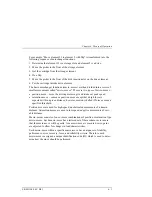
Chapter 6. Theory of Operation
EK–MOL80–SV. B01
6–9
The two large components on the PCA are the Field-Programmable Gate Array
and the microprocessor. The microprocessor is an 80C52 that has flash-
programmable memory on board. (There are no boot ROMs on this PCA).
The chip can be programmed, however it must be disconnected from the PCA to
do so. The Field-Programmable Gate Array can not be programmed.
After the jukebox runs its self test on wakeup, it instructs the SCSI PCA to come
up in whichever mode has been selected by the user. It can come up either as a
repeater or in the LUN mode. Communication from the autochanger controller is
through the GPIO bus cable. (If the GPIO cable is not connected at start up, the
PCA will come up as a repeater).
A “heartbeat” LED is located on the bottom edge of the board. This LED will
continuously flash at a slow rate when power is applied. If the LED is either on
steady, or off, this indicates a problem with the PCA.
In repeater mode, the SCSI PCA looks transparent on the bus and passes all SCSI
transactions through. The interface type may also be converted from single-
ended to differential if that is the interface selected by the slide switch on the top
of the PCA.
A LED, visible through the top of the interface enclosure, is mounted between
the interface connectors on each side. These LEDs light to show which interface
has been selected. If the wrong interface type is connected to the interface
connector on this PCA, the LED will continuously and rapidly flash to alert the
user to this error. No damage is caused to the chips on the PCA by having
connectors in the wrong position.
During powerup, the position of the interface selector switch is checked to see
which external bus is active and if the proper bus type is on the selected interface
port.
If the differential bus is active, the DIFFSENSE signal on the SCSI bus is
checked. If this signal is LOW, it means that a single-ended bus has erroneously
been connected to the differential connector. The bus is immediately made
inactive, to protect the chips.
















































